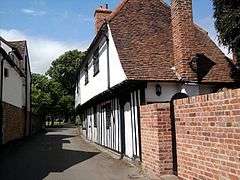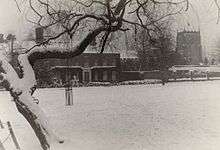Writtle
The village and civil parish of Writtle lies 1 mile (1.6 km) west of Chelmsford, Essex, England. It has a traditional village green complete with duck pond and a Norman church, and was once described as "one of the loveliest villages in England, with a ravishing variety of ancient cottages".[2] The village is now home to Writtle College, one of the UK's oldest and largest land-based colleges and a partner institution of the University of Essex, the grounds of which once housed a Royal hunting lodge, later the possession of the De Brus and De Bohun families.
| Writtle | |
|---|---|
 Aubyns, a half-timbered house dated 1500 | |
 Writtle Location within Essex | |
| Population | 5,383 (2011)[1] |
| OS grid reference | TL6706 |
| Civil parish |
|
| District | |
| Shire county | |
| Region | |
| Country | England |
| Sovereign state | United Kingdom |
| Post town | CHELMSFORD |
| Postcode district | CM1 |
| Dialling code | 01245 |
| Police | Essex |
| Fire | Essex |
| Ambulance | East of England |
| UK Parliament | |
The suggestion that Writtle is the birthplace of Robert the Bruce, as well as his father Robert de Brus, 6th Lord of Annandale, is contested, though its possession and use by both is incontrovertible. From 1996 until 2017 Writtle hosted the annual southern V Festival within the grounds of Sir John Comyn's Hylands Park. At the 2001 census, it had a population of 5,632,[3] decreasing to 5,383 at the 2011 Census.[1]
History
The Romans were present in Writtle[4] shortly after the Roman conquest by Claudius, but the presence of a metalled road,[5] numerous archaeological finds and the ease with which the river can be forded in Writtle are still not significant enough evidence to suggest that Writtle, rather than Chelmsford, was the site of the Roman town of Caesaromagus, as suggested by the Essex historian Philip Morant (et al).[6]
The place-name 'Writtle' is first attested in the Domesday Book of 1086, where it appears as Writelam. It appears in a charter circa 1136 as Writela. This was originally the name of the River Wid, as attested in an Anglo-Saxon charter of 692 where the river appears as Writolaburna. This name is thought to mean 'babbling burn or brook'.[7]
Named in the Little Domesday Book as a Royal demesne (manor) of 194 households, the village boasts the site of one of King John's hunting lodges (circa 1210),[8] sited within the grounds of the present HE institution Writtle College.
The estate and village were later a possession of Isabel de Brus (Bruce), via a 16 October 1241 grant of Henry III[9] and a known residence of her grandson Robert, father to the future king.[10][11] For a time thereafter it was leased to a Francis and Joan Bache, but the estate was taken by Isabel's great-grandson, Robert The Bruce, King of Scots, in the 1320s.[12][13] It was in Writtle in 1302 that Robert had married his second wife, Elizabeth de Burgh; there is some evidence to suggest he was also born in the village rather than in Turnberry Castle, but the story is possibly conflated with that of his father of the same name.
Another well known historic figure who lived in Writtle was Sir John Petre (1549–1613).[14] He sat as a member of parliament for Essex from 1584 to 1587 and also served as Lord Lieutenant of Essex. In 1603 he was raised to the peerage as Baron John Petre, the first baron of Writtle. Baron Petre publicly acknowledged that he was a Roman Catholic and refused to follow the Church of England during the time of Queen Elizabeth I and King James I. He died in October 1613, aged 63, and was succeeded in the barony by his son William,[14] who later married Katherine Somerset. One person from Writtle who did help to bring about the English Reformation was Dr. John Bastwick (1593–1654), a religious zealot who opposed Roman Catholic ceremonial in the years before the outbreak of the English Civil War.[15]
In August 1914 the 4th Battalion of the Oxfordshire and Buckinghamshire Light Infantry Regiment arrived in Writtle. The 4th Ox and Bucks Bn was part of the Territorial Force, or volunteer reserve, of the British Army. While in Writtle the men underwent physical and military training. On 14 October 1914 they paraded in the grounds of Hylands House in the presence of King George V. The Ox and Bucks left Writtle in April 1915.[16]
According to a contemporary newspaper report Writtle was hit by a V-2 rocket on Friday 12 January 1945. The V-2 fell about 200 yards south of the River Wid bridge in a field belonging to Skeggs Farm. The impact crater was 30 feet across by 20 feet deep. 19 properties were extensively damaged and a further 218 slightly damaged including All Saints' Church. No casualties were reported although two families in Bridge street were made homeless.[17]
Climate
Writtle has a mild variety of the British oceanic climate with warm summers at around 23 °C (73 °F) and mild winters with highs of 7 °C (45 °F) but with quite common minor frosts. Precipitation is relatively low by British standards at 591.8 millimetres (23.30 in) during the 1981–2010 average period.[18]
| Climate data for Writtle, 32 m asl, 1981–2010 | |||||||||||||
|---|---|---|---|---|---|---|---|---|---|---|---|---|---|
| Month | Jan | Feb | Mar | Apr | May | Jun | Jul | Aug | Sep | Oct | Nov | Dec | Year |
| Average high °C (°F) | 7.4 (45.3) |
7.7 (45.9) |
10.7 (51.3) |
13.6 (56.5) |
17.0 (62.6) |
20.2 (68.4) |
22.9 (73.2) |
22.7 (72.9) |
19.3 (66.7) |
15.0 (59.0) |
10.5 (50.9) |
7.7 (45.9) |
14.6 (58.3) |
| Average low °C (°F) | 1.5 (34.7) |
1.0 (33.8) |
2.7 (36.9) |
3.8 (38.8) |
6.8 (44.2) |
9.8 (49.6) |
12.0 (53.6) |
11.8 (53.2) |
9.7 (49.5) |
7.1 (44.8) |
3.9 (39.0) |
1.8 (35.2) |
6.0 (42.8) |
| Average precipitation mm (inches) | 53.2 (2.09) |
39.2 (1.54) |
40.2 (1.58) |
41.6 (1.64) |
48.7 (1.92) |
49.9 (1.96) |
44.3 (1.74) |
51.7 (2.04) |
48.6 (1.91) |
64.1 (2.52) |
58.0 (2.28) |
52.3 (2.06) |
591.8 (23.30) |
| Mean monthly sunshine hours | 58.0 | 78.1 | 112.4 | 165.7 | 196.6 | 198.2 | 209.9 | 204.0 | 147.4 | 113.9 | 68.7 | 47.4 | 1,598.2 |
| Source: Met Office[19] | |||||||||||||
Two Emma Toc, Writtle
Writtle holds a distinguished place in the history of radio broadcasting. In the early 1920s it was the site of the experimental Marconi station 2MT ("Two Emma Toc"), from where Captain Peter Eckersley made the name of the village famous with his station announcement "this is Two Emma Toc, Writtle testing, Writtle testing".
The prefabricated hut from which the broadcast was made (constructed for use during the First World War, but never shipped to the war zone) was later relocated to King's Road primary school in Chelmsford, and has now been re-erected with replica equipment at the Sandford Mill museum, near Sandon. The Writtle transmission station was also the last independent outside the BBC, suspending transmission in January 1923. Independent radio did not re-emerge in the UK till the 1960s.
Writtle Church

The Domesday Book mentioning a church and priest in Writtle suggests that Christian worship in the village pre-dated the Norman Conquest;[4] the early-13th-century nave and chancel seem to be extensions of an 11th-century construction, which itself replaced a Saxon church.
During the mediaeval period, the church "changed hands" several times, revenues being received by the Prior of Bermondsey in the 12th century, and then by the Hospital of the Holy Ghost in Rome from the early 13th; the turbulent reign of Richard II saw the church being seized by the king, eventually coming under the control of William of Wykeham's New College, Oxford in 1399.[20]
The church has twice suffered arson attacks in recent history, the first in 1974, the second in 1991.
Longmeads House
Longmeads House is a large Victorian building with grounds, and an important feature of the village. It was built by Robert Woodhouse in the 1880s and remained in the family until it was acquired by the Seabrooke family in 1930. The estate was acquired by Essex County Council in 1950 and is now the village's community centre.[21]
References
- "Civil Parish population 2011". Neighbourhood Statistics. Office for National Statistics. Retrieved 8 September 2016.
- Hope-Moncrieff, A.R. (1909). Essex. A&C Black Ltd.
- "Census 2001: Parish Headcounts: Chelmsford". Neighbourhood Statistics. Office for National Statistics. Retrieved 10 July 2012.
- Cambridge University assessment of the Lordship Campus
- Writtle College Masterplan – history of site>
- Essex Villages: Writtle Archived 8 August 2007 at Archive.today
- Eilert Ekwall, The Concise Oxford Dictionary of English Place-names, p.539.
- The Historic Lands of England, p 120, By Bernard Burke, Published Churton, Clayton & Co 1848
- National Archives, SC 8/93/4605B
- Essex Records Office – Deed – D/DP T1/1770
- Essex Records Office – Deed – D/DBa T2/9
- National Archives, SC 8/95/4727
- National Archives, SC 8/104/5151
- https://www.flickr.com/photos/60861613@N00/4094206042/
- http://www.writtlevillage.co.uk/
- John W. Trusler. 2008. Local Heroes, The Villigers of Writtle Who Gave Their Lives in The Great War.
- Andrew J. Begent. 1999. Chelmsford at War, A chronicle of the country town of Essex during the Second World War. Second Edition. Ian Henry Publications. Page 62.
- "Writtle climate information". Met Office. Retrieved 14 August 2015.
- "Writtle Climate Normals 1981–2010". Met Office. August 2015. Retrieved 14 August 2015.
- All Saints Parish Church Building History Archived 20 August 2008 at the Wayback Machine
- Sivyer, Elaine (November 2008). "A house away from home". Essex Life. Archant. p. 74. Retrieved 24 January 2009. (Registration required).
External links
| Wikimedia Commons has media related to Writtle. |